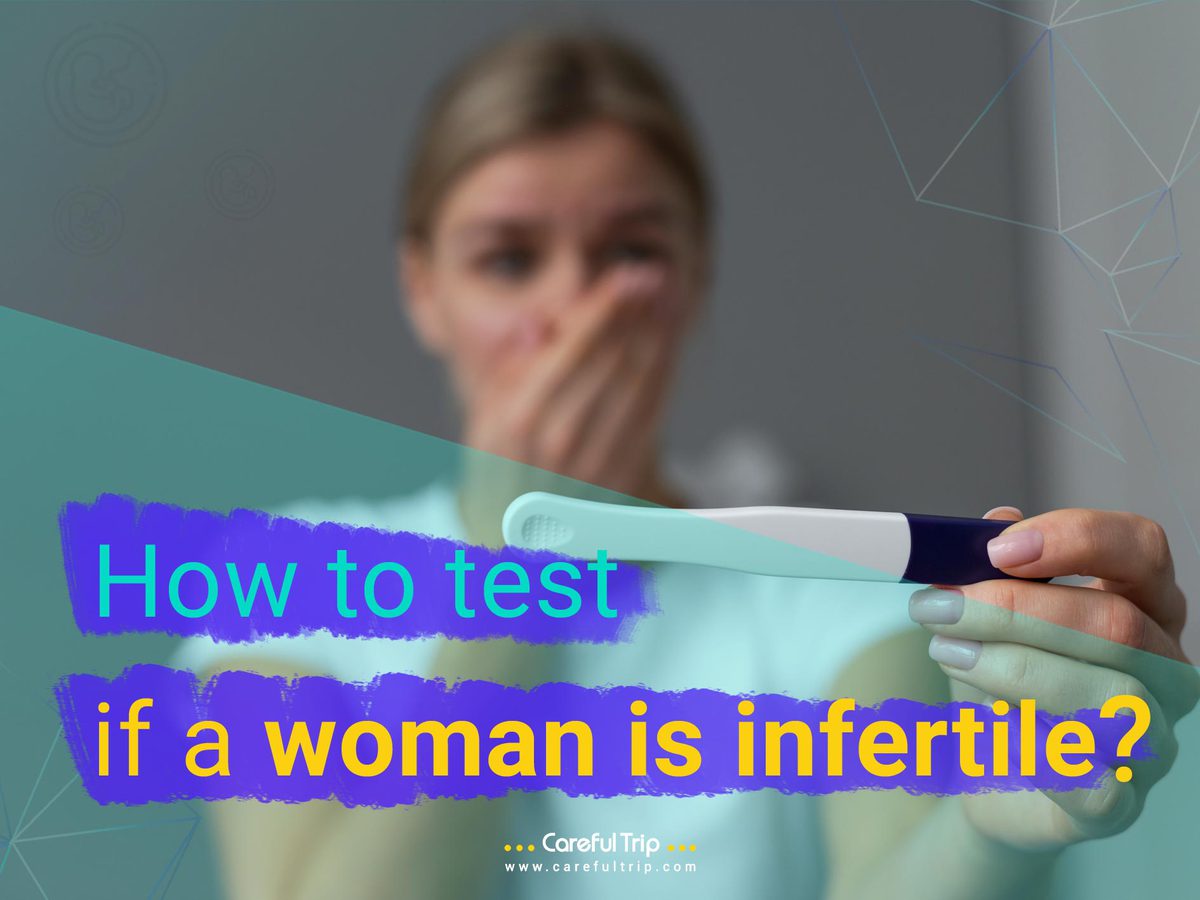
For many women and couples, the inability to conceive can result in feelings of anger, despair, and anxiety, which are sometimes made worse by the mystery of the underlying cause of infertility. World Health Organization (WHO) has reported that 1 in 6 couples worldwide (approx. 17.5%) face infertility, highlighting the importance of understanding and addressing this complex issue.
Recognizing the symptoms and getting a correct diagnosis are frequently the first steps to fertility. Discovering the underlying causes and obtaining an accurate diagnosis is the first step in developing a successful treatment plan. Extensive testing is essential since it helps identify the precise causes of infertility, enabling a customized treatment plan. Taking this proactive measure can significantly increase the likelihood of a successful pregnancy.
Many tests and assessments are available to identify the underlying causes of female infertility. This article thoroughly introduces testing for female infertility, covering imaging scans, physical exams, laboratory testing, medical history evaluations, and specialist procedures. Combining these techniques, doctors examine hormone levels, reproductive organ health, and any structural anomalies that could prevent pregnancy.
Every test is essential to present a comprehensive picture of a woman’s reproductive health and help medical professionals create an efficient treatment strategy. Women and couples can approach their fertility journey with more knowledge and confidence if they grasp these diagnostic tools. This will help them feel in charge of their parenting journey and give them hope. CarefulTrip acts as a facilitating agency for any fertility need, providing consultations on such matters and educating its customers with the vast knowledge of the expert medical staff of Tehran’s MOM Fertility Clinic.
Understanding Infertility
The inability to conceive after a year of consistent, unprotected sexual activity is the standard definition of infertility. This period is reduced to six months for women over 35 because of the age-related drop in fertility. Numerous causes, including hormone imbalances, anatomical issues with the reproductive system, and lifestyle choices like stress, food, and exposure to pollutants, can lead to infertility.
Thyroid or pituitary gland problems, as well as diseases like polycystic ovarian syndrome (PCOS), which can interfere with regular ovulation, can all contribute to hormonal imbalances. Anomalies in the uterus, fallopian tubes, or ovaries, such as fibroids, polyps, or obstructions that stop the sperm and egg from meeting, can indicate structural issues. Reduced fertility can also be attributed to lifestyle problems, such as obesity, smoking, excessive alcohol intake, and high levels of stress. A comprehensive and systematic approach is needed to determine the precise cause of infertility. Usually, this involves a complete medical history and physical examination, followed by focused laboratory testing and imaging examinations to identify the accurate problems preventing conception.
For more information, read:
Initial Evaluation of Woman’s Fertility
To understand why a woman is infertile or how to test it, first, a woman’s fertility has to be adequately evaluated and tested to get a clear overview of their condition.
Medical History
As we evaluate a patient’s condition, the first step in diagnosing infertility involves taking a detailed medical history. This includes:
- Menstrual History: Regularity, duration, and symptoms of menstrual cycles.
- Pregnancy History: Previous pregnancies, miscarriages, or abortions.
- Sexual History: Frequency and timing of intercourse, history of sexually transmitted infections (STIs).
- Medical and Surgical History: Any chronic illnesses, surgeries, or treatments that might affect fertility.
- Family History: Genetic conditions or fertility issues in the family.
- Lifestyle Factors: Habits like smoking, alcohol consumption, drug use, and occupational exposures.
Physical Examination
A physical examination can reveal information about underlying medical conditions that may be linked to infertility. This comprises:
- General Health Assessment: Checking weight, body mass index (BMI), and overall physical health.
- Pelvic Examination: Evaluating the reproductive organs for abnormalities, infections, or signs of endometriosis.
Laboratory Tests for Infertility
When the medical history of a woman is checked, and a physical examination is done to assess her causes of infertility, there are further tests done in the lab to clarify the situation more. Testing the Hormone levels or a patient’s ovarian reserve is usually the next step.
Hormone Testing
Hormone levels are essential for controlling ovulation and the menstrual cycle. Standard hormone tests consist of the following:
- Follicle-Stimulating Hormone (FSH): Evaluates ovarian reserve and function.
- Luteinizing Hormone (LH): Helps identify issues with ovulation.
- Thyroid-Stimulating Hormone (TSH): Assesses thyroid function, as thyroid disorders can affect fertility.
- Prolactin: High levels can interfere with ovulation.
- Estradiol: Provides information about ovarian function.
- Anti-Müllerian Hormone (AMH): Indicates the size of the remaining egg supply (ovarian reserve).
Ovarian Reserve Testing
Ovarian reserve tests measure the capacity of the ovaries to produce eggs that can be fertilized. These tests include:
- Antral Follicle Count (AFC): Ultrasound count of the visible follicles in the ovaries.
- AMH Levels: A blood test to measure the anti-Müllerian hormone levels.
Imaging Studies
Ultrasound
Pelvic ultrasound is a standard imaging test used to visualize the reproductive organs. It helps in assessing:
- Ovarian Follicles: Number and size of follicles.
- Uterus: Shape, size, and any abnormalities like fibroids or polyps.
- Endometrial Lining: Thickness and pattern are crucial for implantation.
Hysterosalpingography (HSG)
An X-ray technique called hysterosalpingography (HSG) is used to look inside the uterus and fallopian tubes. During the operation, a dye is injected into the uterus, and X-rays are obtained to determine whether the dye efficiently passes through the fallopian tubes. This aids in locating obstructions or structural irregularities that can keep sperm from reaching the egg.
Specialized Procedures
Hysteroscopy
Hysteroscopy involves inserting a thin, lighted telescope (hysteroscope) through the cervix into the uterus. It allows the doctor to directly view the inside of the uterus and identify issues such as polyps, fibroids, adhesions, or congenital anomalies.
Laparoscopy
Examining the organs within the abdomen is possible using a minimally invasive surgical procedure called a laparoscopy. A small incision is made close to the navel, and a laparoscope—a thin, illuminated tube with a camera—is inserted. Conditions that may not be detectable by other means, such as endometriosis, pelvic adhesions, and tubal obstructions, can be diagnosed using a laparoscopy.
Additional Tests and Considerations for Infertility
Genetic Testing
If there is a family history of genetic illnesses, miscarriages, or genetic abnormalities from prior pregnancies, genetic testing might be advised. Typical genetic examinations consist of the following:
- Karyotyping: Analyzes the chromosomal structure to detect genetic abnormalities.
- Carrier Screening: Identifies if an individual carries genes for specific genetic disorders.
Infectious Disease Screening
Sexually transmitted diseases (STIs) like gonorrhea, HIV, and chlamydia are essential to screen for since they can affect fertility and pregnancy outcomes.
When to Seek Medical Help for Infertility
If a woman under 35 has not been able to conceive after a year, she may want to consult a doctor. When they have tried for six months, women over 35 should get support. Furthermore, women should get evaluated sooner if they have a history of reproductive surgery, endometriosis, painful or irregular periods, pelvic inflammatory disease (PID), or any other known risk factors.
Infertility Treatment Options
Once the cause of infertility is identified, several treatment options are available. Although these treatment options depend on the underlying issue:
Medications
- Clomiphene Citrate (Clomid): Stimulates ovulation in women who do not ovulate regularly.
- Gonadotropins: Hormonal injections that stimulate the ovaries to produce multiple eggs.
- Metformin: Used to treat insulin resistance in women with polycystic ovary syndrome (PCOS).
- Thyroid Medications: Treat thyroid disorders that can affect fertility.
Assisted Reproductive Technologies (ART)
- Intrauterine Insemination (IUI): At approximately the time of ovulation, sperm are inserted directly into the uterus.
- In vitro fertilization (IVF): It entails taking the eggs out of the ovaries, fertilizing them in a lab with sperm, and then putting the developing embryos into the uterus.
- Intracytoplasmic Sperm Injection (ICSI): A single sperm is injected directly into an egg during IVF to assist with fertilization.
Surgery
Surgery may be required to treat diseases like endometriosis or tubal obstructions, remove fibroids or polyps, or rectify structural defects.
Lifestyle Modifications
This one might sound simple, but healthy living is always effective. This is why adopting a healthy lifestyle can significantly improve fertility. Key recommendations include:
- Maintaining a Healthy Weight: Being underweight and overweight can affect a woman’s hormone levels and ovulation.
- Exercise Regularly: Moderate exercise can improve overall health and reduce stress.
- Quit Smoking: It’s been established that smoking can reduce fertility in both men and women.
- Limit Alcohol Intake: Excessive alcohol consumption can impair fertility.
- Reduce Stress: Stress management techniques such as yoga, meditation, and mindfulness can improve fertility.
Psychological and Emotional Support
Infertility can be emotionally taxing. Counseling and support groups can offer helpful coping mechanisms and assistance. Individuals and couples facing infertility can benefit from the emotional support of licensed counselors with expertise in fertility difficulties.
Final Words
Testing for female infertility involves a comprehensive approach that includes medical history assessments, physical examinations, laboratory tests, imaging studies, and specialized procedures. Identifying the underlying cause of infertility is the first step toward finding an effective treatment.
By seeking medical advice and undergoing appropriate testing, women can increase their chances of achieving a successful pregnancy. Adopting a healthy lifestyle and seeking psychological support can improve overall well-being and fertility.
If you suspect you are experiencing any form of infertility, contact us at CarefulTrip for a free consultation. CarefulTrip, in partnership with the excellent MOM Fertility Clinic in Tehran, ensures that you receive a tailor-made roadmap for how to confront your infertility. We facilitate your every need in your quest to become a parent.
